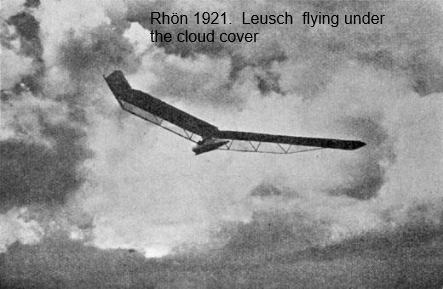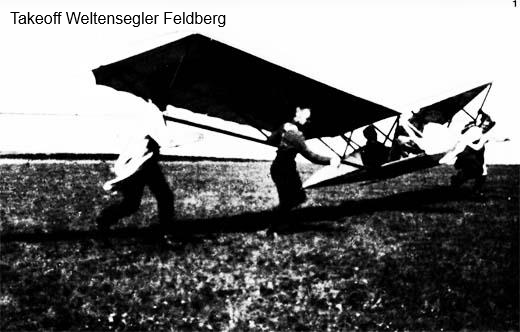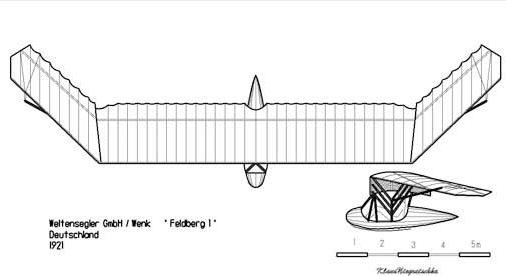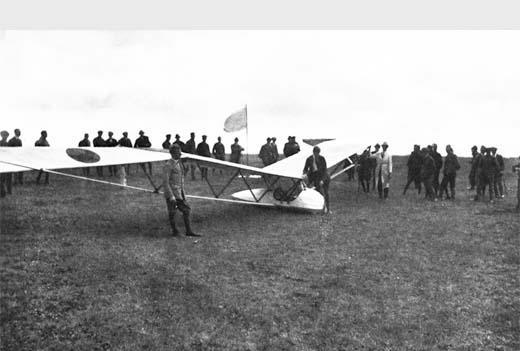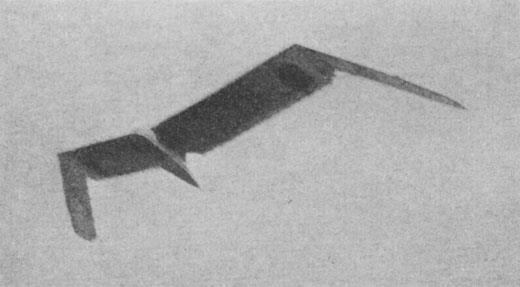The tailless glider was controlled by a curious and quite unorthodox arrangement of cables and springs. Moving the control column forward would bring both wing tips together to a higher angle of attack. The resulting increase of lift behind the centre of gravity would cause the glider to pitch nose down. To return to level flight the pilot would move the stick back but there was no positive link between the pilot's hand and the wing tips. The springs in the control circuit were expected to provide the necessary corrective warp. Moving the stick to left or right would pull one wing tip down but not the other, to bank and turn, and again the springs, not the pilot's hands, should return the wings to the neutral position. Why Wenk adopted this system is not clear but it may be that, like many others at this time, he hoped to extract energy from gusts of wind, a kind of dynamic soaring. A gust would cause the springs to compress slightly.
The wing tips would yield under the extra pressure, pitching the glider nose up. The gust passed, the springs would return automatically to neutral, all before the pilot could react. There would be a kind of flapping motion which would transmit some gust energy to the glider and perhaps enable it to gain height. It remained to be
tested in practice.
The glider was ready for trial on 14th August. The company test pilot, Willy Leusch, was experienced in powered aircraft. The glider, with him in the cockpit, was lifted bodily by the crew, carried forward at a gentle trot and thrown off into the breeze coming up the slope. At first all went exceptionally well. The Weltensegler, after a momentary hesitation, flew forward and smoothly climbed to about 80 metres above the launch point. But a turn to the left became a steepening spiral dive and the airspeed increased rapidly. In aerodynamics, loads generated by an airflow increase according to the square law: twice the speed means four times the force. The springs could not provide sufficient corrective power. Within seconds the wing fluttered and collapsed, the nacelle fell down the slope with the remnants of the flimsy wing trailing like a banner.
Leusch was killed. Gloom descended over the camp. Nonetheless, Leusch had soared. However briefly, a glider had gained altitude in flight after a gentle launch. Recovered from their
shock, the witnesses remembered but at the time, not many understood. It was still supposed by some that gust energy and instant changes of the wing's angle of attack to the airflow, were responsible for this, drastically limited, success. The idea of gust soaring was not abandoned; even Klemperer was attracted by it, other leading scientists supported the notion. The proposed solution was, not to rely on dubious springs and automatic controls, but to let the pilot alter the wing angle of attack instantly on feeling a gust, riding it up, then gliding forward anticipating another surge and ready for it. Probably today it would be recognised that Leusch was carried up simply by slope lift, the air rising up the hill. Perhaps a thermal was passing through as he took off.
| Type |
|
| Dimensions |
Length 3,50 m, height , span 16,00 m, wing area 17 m2 |
| Weights |
Empty 43 kg, max. 113 kg, wing loading 6,2 kg/m2
|
| Performance |
Max.. speed , |
| Type |
Werk.Nr |
Registration |
History |
|
|
|
Designed by Friedrich Wenk in 1921. The glider was built in a workshop that the firm Segelflugzeugwerke GmbH opened at the Wasserkuppe . On 14 August 1921 the machine is ready for first flight. After a flawless launch and altitude hold about 80 meters in a straight line, the unit went into spiral dive as soon as the pilot tried to make a turn and crashed. Wilhelm Leusch was killed instantly. The flight lasted one and a half minute. |
Presentation of the Weltensegler Feldberg moments before the tragic
flight
